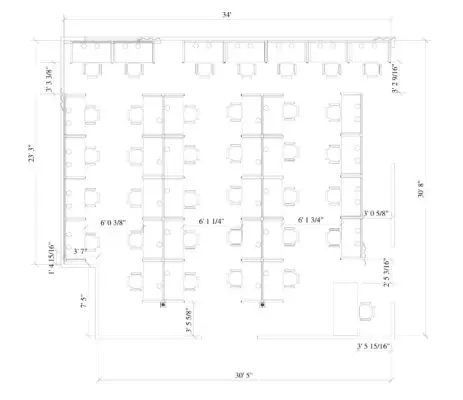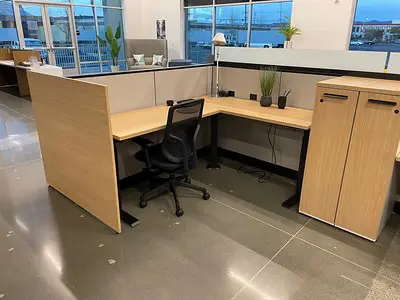Cubicles: Everything You Need to Know About Buying, Designing, and Loving Them
What is a Cubicle?
A cubicle is more than just a workspace; it’s a practical solution for creating privacy and organization in office environments. Introduced in the 1960s, cubicles were designed to foster productivity by minimizing distractions while maintaining an open-office concept. A standard cubicle typically includes walls or panels, a desk, and optional accessories like cubicle storage and cubicle shelves to maximize utility. In today’s offices, cubicles come in various designs, from classic high-walled options to low-profile desks that encourage collaboration.
How Big is a Cubicle?
The size of a cubicle varies based on its intended purpose and the available office space. Common sizes range from 6’x6’ for standard workspaces to 8’x8’ for executives or those requiring additional room. Smaller cubicles, often referred to as telemarketing cubicles, measure around 4’x2’. These compact designs are perfect for teams that require multiple workstations within limited space. When determining the size of a cubicle, consider your employees’ workflow and the types of tasks they perform to create an optimized setup.
Where to Buy Cubicles?
Finding the right cubicle supplier can make all the difference in creating a productive office environment. Retailers specializing in office furniture offer a range of options from budget-friendly solutions to premium designs. Look for suppliers that provide customization options, including panel colors, integrated cubicle shelves, and ergonomic layouts. Exploring used cubicle options is another great way to save costs without compromising on quality. Ensure the supplier offers a range of cubicle storage and accessories to meet your specific needs.
How to Make a Cubicle?
For businesses seeking DIY solutions, creating a cubicle involves assembling panels, desks, and storage elements into a functional layout. Start by selecting durable materials like laminate or fabric-covered panels for walls. Include essentials such as desks with built-in cable management systems to keep cords organized. Adding cubicle accessories like magnetic boards, hanging organizers, or customized lighting can improve functionality and make the workspace more inviting. DIY cubicles also allow for personalization, giving employees the ability to make their spaces unique and comfortable.
Does Anyone Like Cubicles Better?
The debate between open offices and cubicles has been ongoing for years. While open-office layouts promote collaboration and creativity, many professionals prefer cubicles for the privacy and focus they provide. Studies show that employees working in cubicles experience fewer distractions and report higher levels of productivity. Cubicles also allow for customization, as employees can use cubicle shelves and other accessories to make their spaces their own. In hybrid office models, cubicles remain a critical component, balancing collaborative spaces with areas designed for concentration.
Enhancing Your Workspace with Cubicle Accessories
Adding the right cubicle accessories can transform a basic workstation into an organized and personalized hub of productivity. Consider the following:
- Cubicle storage: Include overhead bins, filing drawers, or modular storage units to keep items out of sight.
- Cubicle shelves: Perfect for displaying personal items, storing work essentials, or organizing books and binders.
- Cable management: Keep wires neat with cable clips, under-desk organizers, or dedicated wire channels.
- Lighting: Task lights or LED strips reduce eye strain and improve workspace aesthetics.
- Ergonomic tools: Adjustable monitor arms, keyboard trays, and footrests enhance comfort and reduce fatigue.
What Makes an Ideal Cubicle Layout?
An ideal cubicle layout is functional, comfortable, and tailored to the needs of your team. Consider the following factors:
- Space utilization: Arrange cubicles to maximize available floor space while allowing for ease of movement.
- Collaboration vs. privacy: High walls provide privacy for focused tasks, while low-profile designs encourage interaction.
- Customization: Add cubicle storage and cubicle shelves to ensure that each workstation meets individual needs.
- Lighting: Ensure that natural and artificial lighting is evenly distributed across the workspace.
How to Arrange Cubicles in a Small Space
In smaller offices, arranging furniture efficiently is essential. Start with compact cubicle designs or telemarketing cubicles that optimize available space. Use vertical solutions like cubicle shelves for storage, and choose furniture with a smaller footprint, such as narrow desks or stackable chairs. Multifunctional furniture, such as storage units with integrated seating, can also help save space. Thoughtful layouts ensure that even small offices feel spacious and functional.
Customizing Cubicles for Different Work Styles
Not all employees work the same way, and customizing cubicles to suit diverse work styles can improve productivity. For example, creative professionals may prefer cubicles with open layouts, low walls, and cubicle shelves for displaying inspiration boards or tools. On the other hand, administrative roles may require high-walled cubicles with added cubicle storage for files and equipment. By tailoring cubicle setups to individual and team needs, employers can create an environment that supports efficiency and satisfaction.
The Role of Cubicle Storage in Organization
Cubicle storage plays a crucial role in keeping workspaces tidy and functional. Overhead cabinets provide a space-saving solution for storing items that aren’t frequently used but need to be easily accessible. File drawers and locking storage units help secure sensitive documents, while open cubicle shelves offer a place to display items or keep frequently used supplies within reach. Investing in smart storage solutions ensures that workspaces remain organized, reducing stress and boosting productivity.
Trends in Modern Cubicle Design
Modern cubicle designs are far from the drab and monotonous setups of the past. Today’s cubicles incorporate sleek materials, vibrant colors, and thoughtful features like glass panels or ergonomic accessories. Many companies are also embracing modular cubicle designs, which allow for quick reconfigurations based on changing team sizes or needs. These designs often include built-in cubicle accessories like magnetic boards, integrated lighting, and power outlets to enhance functionality.
Benefits of Investing in Cubicle Accessories
Cubicle accessories not only improve the functionality of a workspace but also contribute to employee well-being. Accessories like ergonomic footrests or adjustable monitor arms reduce strain during long work hours. Cable management tools prevent tripping hazards and maintain a clean appearance. Meanwhile, decorative items such as plants or framed photos can personalize a space, making employees feel more comfortable and engaged in their environment.
How Cubicles Promote Employee Well-Being
Cubicles can support employee well-being by offering a sense of privacy and control over their environment. Unlike open-office plans, cubicles help reduce noise and visual distractions, which are common sources of stress. Additionally, employees can personalize their cubicles with accessories and décor that reflect their personalities, boosting morale. Adding ergonomic furniture and cubicle storage solutions further enhances comfort and reduces workplace fatigue.
Why Size Matters in Cubicle Selection
Selecting the right cubicle size is critical to creating a comfortable and productive workspace. Smaller cubicles, like 4’x2’ designs, are ideal for telemarketing teams or compact offices. Larger options, such as 8’x8’ executive cubicles, offer room for more equipment and storage, accommodating roles with higher workspace demands. Proper sizing ensures that employees have enough room to work comfortably without wasting valuable office space.
Maximizing Small Office Spaces with Cubicles
For small offices, every square foot counts. Compact cubicles with integrated cubicle storage and accessories are ideal for these environments. Modular designs allow businesses to rearrange workspaces as needed, making the most of limited space. Incorporating vertical storage, such as overhead bins or wall-mounted cubicle shelves, further optimizes the layout while maintaining functionality.
How to Choose the Best Cubicles for Your Business
Choosing the right cubicles starts with understanding your business needs. Consider factors like the size of your team, the nature of their work, and the available office space. Look for cubicles with customizable features, such as adjustable shelves, integrated cable management, or modular panels. Don’t forget to think about aesthetics—cubicles should reflect your brand identity while providing comfort and utility for employees. Once you’ve established your basic necessities, you’ll need to have a floor plan drawn up and begin to planning and procurement process. Important factors to consider are:
- Electrical availability and data entry points throughout the space.
- Sufficient walkway around the cubicle arrangements.
- Lead time and installation time.
- Move-in and insurance requirements.
- Total cost or cost per seat on average.
When working with your cubicle vendor, all of these factors will come in to play. Typically, used cubicles tend to have a much shorter lead time, whereas new cubicles tend to have a longer lead time.
Need a cubicle vendor? Get in contact with a cubicle professional.
Why Cubicles Are Still Relevant Today
Despite the rise of open-office trends, cubicles remain essential for creating adaptable and efficient workspaces. They offer employees the ability to focus, customize, and store their belongings in an organized manner. With features like cubicle storage, cubicle shelves, and modular designs, they are a versatile solution for modern offices. Whether you’re outfitting a small business or a large corporate space, cubicles provide the privacy and structure that many employees value. Cubicle finishes, colors, and styles can be highly customizable allowing you to have creative freedom to use design elements to positively impact your company’s culture and brand impact internally.
Final Thoughts
Cubicles offer a blend of privacy, functionality, and adaptability that appeals to a wide range of professionals. Whether you’re wondering what is a cubicle, how big is a cubicle, or where to buy cubicles, understanding your needs will help you make the best decision. By incorporating thoughtful designs and cubicle accessories, you can create a workspace that fosters productivity and satisfaction.

